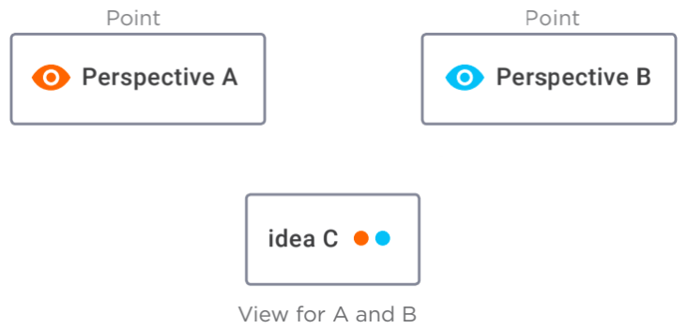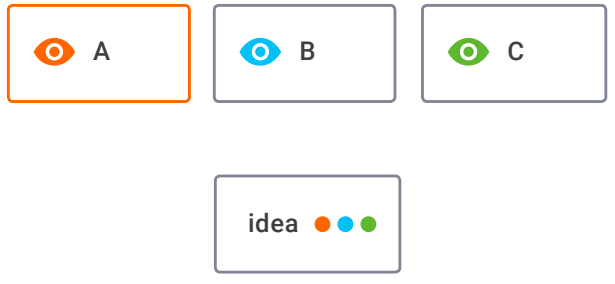The Four Simple Rules of Systems Thinking: The Perspective Rule
 Derek & Laura Cabrera
·
3 minute read
Derek & Laura Cabrera
·
3 minute read
Excerpt from the book: Systems Thinking Made Simple, Chapter 3
Perspectives Rule
Any Thing or Idea Can Be the Point or the View of a Perspective
In systems thinking, perspectives are as ubiquitous as relationships. In many cases, it is the various perspectives that factor into complex systems and their wicked problems that create the need for systems thinking. Most of the time, we think of a perspective as being something that a person has (i.e., “his or her perspective”), but a perspective can also be a lens through which we look at some other idea and that lens can be a thing, an event, a person, a place, and even an idea. Whether you call it a lens, a point of view, a frame, mindset, or worldview, all are synonymous with or forms of perspective-taking. Perspective-taking is essential to systems thinking because understanding systems is in large part understanding how those systems look from various perspectives.
In the same way that Figure 3.16 illustrates that two angles on the same object can yield very different perspectives, we intuitively understand that the same is true about all things and ideas. But perspectives are not irreducible, they are comprised of two lesser elements: a point and a view.
In order to capture this abstract underlying structure, we programmed these little idea nodes to be able to become a point or a view (or in some cases both) so that we can easily visualize perspectives. You can see in Figure 3.17 that there are two perspectives that are each made up of a point and a view. In this case, the view is the same for both perspectives (idea C). Any idea or thing or even a whole system (i.e., any card) can be a point, or a view, or both.

In many cases, it is the various perspectives that factor into complex systems and their wicked problems that create the need for systems thinking.

We represent perspective by giving the highlighted perspective a colored outline (here, orange for A), and differentiating the point from the view with an eye icon (👁️ ). In Figure 3.17, we see three different points looking at the same view (i.e., three perspectives).

Perspectives can be used to make us expand our thinking and include more options (i.e., divergent thinking). It can also be used to restrict our thinking and cause greater focus (i.e., convergent thinking). You could say, for example, “let’s look at this topic from the perspective of X, and Y, and Z” and therefore cause thinking to expand and include more ideas. In contrast, you could also say, “let’s only look at this topic from the perspective of X” and therefore occlude other perspectives on the topic. This allows us to focus on the salient issues at hand when necessary. This can be particularly useful in facilitating team meetings or classrooms where the facilitator needs to keep people focused and on task but also avoid giving the impression that divergent thinking isn't valued: "There are many other important perspectives on this topic, but today we want to focus on only this perspective."
Systems Thinking Made Simple
Now you can see that what we mean when we named this book “Systems Thinking Made Simple” is not to communicate that we are simplifying it per se. Instead we are showing that systems thinking is actually a complex, adaptive, and emergent phenomenon that is based on simple rules: DSRP. It just requires a little practice to get your brain in the habit. For many, we have found that the best way to do that is by visually mapping mental models, which we'll explore more thoroughly in the next section. It will also help to understand that while these rules are simple, their implications can be quite surprising. In chapter 5, “Use And Reuse Cognitive Jigs,” you'll see that common structures emerge out of systems thinking; knowing these structures will make you a faster and better systems thinker and help you solve problems in your topical areas of concern. In chapter 6, “Make Structural Predictions,” you'll learn that DSRP can be used to discover new knowledge in any discipline, while chapter 7, “Embrace And/Both Logic,” demonstrates how DSRP simple rules underlie an entirely new and powerful logic. In chapter 8, “Everyday and Advanced Applications of DSRP,” you'll see that DSRP simple rules underlie all other systems modeling techniques. Finally, in section 3 of the book, "7 Billion Systems Thinkers," you'll learn both how DSRP can lead to a change in the way we think about personal development, education, and employee training, as well as how these rules can transform organizations through systems leadership.
.png?width=150&height=150&name=CRL%20GOAT%20Logo%20(4).png)


